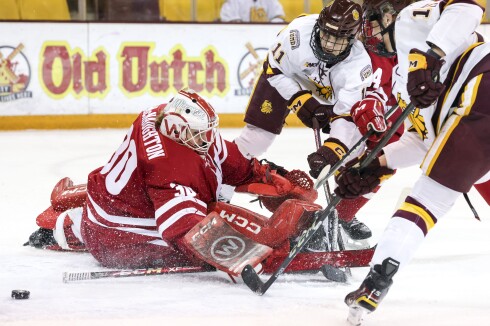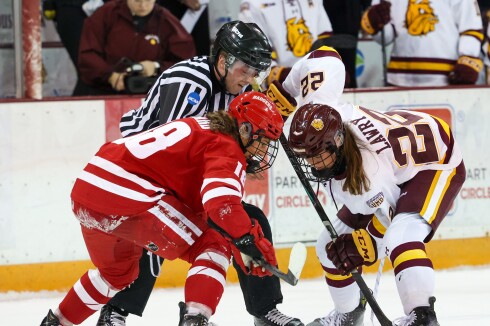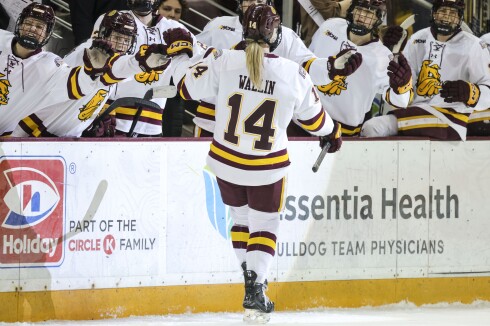Minnesota Duluth men’s freshman goaltender Adam Gajan had to sit out the Bulldogs' first game of the 2024-25 season. He was deemed ineligible for one game because the Slovakian played half of an exhibition in his home country during the COVID-19 pandemic in 2020-21.
Gajan himself wasn’t playing for a pro team, but for the country’s national team development program against a pro team. However, the NCAA deemed it to be a professional contest. So they made him sit for his sin.
ADVERTISEMENT
“Because of COVID rules, there was just professional hockey allowed in Slovakia,” Gajan said. “So they made some extra games, exhibition games, against the NTDP in Slovakia. It was a junior team playing in professional jerseys so it looks like we are a professional team because of COVID rules.”
UMD women’s sophomore goaltender Eve Gascon also played in what the NCAA would deem “professional games” and for a “professional team” back in 2021-22 when she suited up and started two regular season games for the Gatineau Olympiques in the Quebec Maritimes Junior Hockey League.
“It was so fun. I remember every moment of it,” said Gascon, who at age 18 was one of just four women to play a Canadian Hockey League game, and the first female goaltender in 22 years to win a CHL game. “I just had the chance to grow so much. Having to deal with that pressure with the media and the fans, it was hard at first, but when I stepped back, it was a good experience. The guys were always super nice with me. The games were a high level of hockey. It made me grow in a way I can’t describe.”

Gascon didn’t have to sit out a single game, despite the NCAA’s longtime stance that major junior teams and leagues in the CHL — like Gatineau and the QMJHL — are professional teams.
That’s because the NCAA had different rules for men’s and women’s hockey, archaic rules in the age of name, image and likeness (NIL) legislation that are now ancient history.
The NCAA Division I Council today adopted a rules change that will make Canadian major junior players eligible for NCAA Division I hockey, effective August 1, 2025.
— College Hockey Inc. (@collegehockey) November 7, 2024
Got questions? We have answers👇
🔗https://t.co/VSpt3H392b#collegehockey | #NCAAHockey
For decades, men have been banned from playing major junior in Canada and the United States because some players in CHL leagues are under NHL contracts. They’ve signed pro deals already, but have been sent back to their major junior team for more seasoning.
The CHL ban has also extended to any and all leagues that the NCAA deems to be professional, all to keep future NCAA prospects out of the CHL. That’s why Gajan got dinged for his half an exhibition in Slovakia.
ADVERTISEMENT
This isn’t an issue in women’s hockey because the sport is protected by the following clause in the NCAA rule book:
In sports other than men's ice hockey and skiing, before initial full-time collegiate enrollment, an individual may compete on a professional team, provided the individual does not receive more than actual and necessary expenses to participate on the team.
That clause is why Gascon could play in the CHL. It’s why Emma Soderberg played two full seasons of pro hockey in Sweden’s SDHL before coming to UMD. The SDHL is where future Bulldogs women’s defenseman Linnea Natt och Dag is playing in 2024-25. It’s the 18-year-old’s fourth season in the league, having played with former Bulldogs Anneke Linser and Michelle Lowenhielm in the past.
The NCAA is righting its wrong after being sued for antitrust violations this fall. A proposal was introduced in October allowing men’s prospects to play major junior and play for professional teams “as long as they are not paid more than actual and necessary expenses as part of that participation.” The proposal was approved at the NCAA’s meeting in November.
Gascon said a lot of her Gatineau teammates would have liked to play in the NCAA. It’s a high level of hockey, but the QMJHL is also a really good league to play in. The opportunity to do both would be a great way for players in Quebec to grow on and off the ice, she said.
“I think it can be really cool for them,” Gascon said. “I know that for the NCAA for men, the guys are coming in older than the girls. I think they can have this balance of playing in the QMJHL, a good league, and then coming to the NCAA and continue their studies and stuff. I think it can be cool. It could be a really good opportunity for a lot of Quebec guys.”
CHL players who have signed NHL deals are still banned from participating in the NCAA. They shouldn’t be.
ADVERTISEMENT
Instead, the NCAA should allow all college athletes to sign with NHL, PWHL, NBA, WNBA, NFL or MLB teams while retaining eligibility, as long as they don’t play a regular season game in those leagues.
What’s the difference these days between an athlete getting a signing bonus from the Minnesota Wild and taking an endorsement deal with Chipotle?
Why not let an undrafted free agent like Ben Steeves or an NHL draft pick like Dominic James sign a pro deal — giving an NHL team peace of mind that a player won’t go elsewhere after college — and stay in school to get better on the ice while earning a degree?
No one loses in this scenario. Not the student-athlete. Not the school, which has something new to market. Not the professional team that might be signing a player who isn’t really ready for the pros.
The NCAA can be proactive and make these moves now, or wait for another lawsuit to come along.
This story was updated at 2:40 p.m. on Nov. 7, after the NCAA Division I Council adopted the rule change that lifted the CHL ban. It was originally posted at 4:23 p.m. on Oct. 16.
















